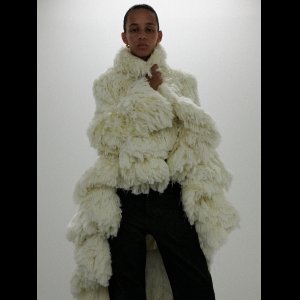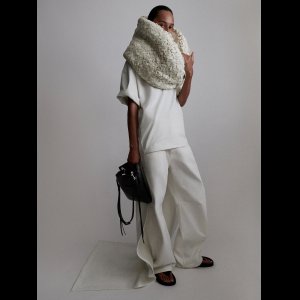I
This conversation reminds me an awful lot of when Jil Sander evolved her style from what had essentially become a common sense of style that COS became synonymous of. You could see that both in her and Helmut around the time they sold to Patrizio Bertelli that they were embracing a direction that wasn’t as minimal as the fashion they were known for in the 1990ies. I would go so far as to say a lot from this brief period of time is what inspired Phoebe Philo at Celine, which is why I will never cut her more slack than that and forever hold Jil in higher regard to her.
What I find the most missing in Phoebe Philo’s present work (and this is again something I will hold her accountable for in comparison to Jil Sander) is that she hasn’t really developed a signature cut the way a design from Jil Sander or Hedi Slimane woukd unmistakably made it one of theirs'. The degree of oversize, with the sleeves of her jackets and tailoring obscuring the wearer's hands and the proportions were not *that* exaggerated during her Celine years and I will agree that the droopy look most of the shown looks are giving are indeed more reminiscent of Demna's Balenciaga.
The result is that the end result doesn’t look like she is much 'ahead' of her peers or giving the market something that hasn’t been there prior to her new namesake brand - I would go as far as to say that what Jil Sander brought to Uniqlo during her brief return was something that indeed had before gone missing with her and has since vanished since she left. The cuts, the fabrics, the details were 100% Jil Sander, I can tell by the styling of her garments that it’s by her much in the way a Hedi Slimane jacket will use a specific fabric, have a very exacting lapel shape and stiff canvassing, more akin to a strict uniform jacket than Milanese or Neapolitan tailoring). That particular 'soul' is something only a designer with a steadfast aesthetic has and may receive them the criticism of a lack of adaptability when the mood in fashion changes. But in turn, those designers really create a monolithic identity that I don’t think Phoebe Philo can yet claim for herself.
She makes perfectly fine, desirable clothes a certain type of woman likes to wear but to me, she will forever be a product of a time when designers were shaped into creative directors and not authors of their very own artistry.
Interesting…
For me, I think sometimes we assume that aesthetic informs everything when sometimes, it’s much more pragmatic and maybe philosophical (without sounding pretentious).
A langage is developed through repetition but also, what is interesting is that, most of the time, we see that a designer continues a story where it stopped.
What Phoebe is doing in 2023/2024 is a continuation of what she stopped in 2018. When you look at her 2017/2018 collections, this is it. But during her absence, the mass had the time to digest her aesthetic, to edit what they loved about it, to romanticize also things. But the evolution of her work seems natural in regards to the evolution of her life. Is she that much different today as she was when she left Celine? I don’t think so. However the woman she was at Celine was different to the one she was at Chloe.
Hedi Slimane is a interesting case. I think he is the same man he was at YSL in 1998. What has changed is that he is not young and so his approach to youth has become romantic. Essentially, he is dressing the same man. He is dressing the same way. His woman is the same and so, repetition has allowed him to sharpen his « propos ».
Jil Sander had a career that extended to many decades. But despite all the aesthetic differences, she has always dressed the same man/woman. That’s why for me it’s difficult to appreciate the new Jil Sander. In a way, minimalism is almost irrelevant because she was making clothes for an active woman/man.
But I don’t personally think about Jil Sander in terms of silhouette as much as I think in terms of idea of a woman that informs a silhouette.
For me, the JS woman is a professional or active woman at heart. For me, Phoebe Philo has evolved into a bourgeoise. When you look at the look she wore to take her bow at the end of her first Celine runway show, it is the uniform of a bourgeoise.
When I think about Margiela, I think about a silhouette. I think about a shoulder and the evolution of that shoulder. I think about easy silhouettes that were going from a loose straight dress to a skintight jersey one. A certain idea of comfort. And I think about awkwardness.
For me, the most interesting thing to see is the evolution of the body of work of a designer beyond the relevance at a certain moment. Anthony Vaccarello is having a moment at Saint Laurent but essentially, it’s a non event in the history of the house or fashion.
When you look at the work of Alber, Tom, Hedi (and even Stefano) their time at Saint Laurent informed something important in their body of work.
When Alber joined Lanvin after that 1 Krizia collection, you understand that his last YSL collection probably had a defining impact on his design sensibility. When Tom launched his menswear/womenswear, it’s the continuation of his last YSL years. But the audience wanted Gucci from him.
Jil Sander, at her peak, defined the uniform of a professional woman. Phoebe Philo for me, made women want to look like bourgeoises.



